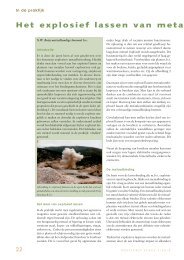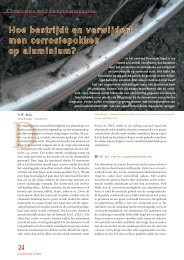Water blasting of stainless steel - Innomet BV
Water blasting of stainless steel - Innomet BV
Water blasting of stainless steel - Innomet BV
Create successful ePaper yourself
Turn your PDF publications into a flip-book with our unique Google optimized e-Paper software.
WATER BLASTING<br />
The surface:<br />
A topographical study conducted by TNO found that ceramic and<br />
glass beads produce a relatively rough surface. Fig. 12 illustrates a<br />
surface that has been glass bead blasted and the average<br />
roughness here is Ra = 1.257 µm. Ceramic bead <strong>blasting</strong> also<br />
produced a result that was very similar to that <strong>of</strong> glass bead<br />
<strong>blasting</strong>, with an average roughness <strong>of</strong> Ra=1.490 µm. This is<br />
represented two-dimensionally in Fig. 14.<br />
Fig. 15 shows a topographical representation <strong>of</strong> a water jet<br />
blasted surface and Fig. 16 shows a two-dimensional image. What<br />
is striking is that the roughness produced is a mere 0.26 µm,<br />
which is exceptionally smooth.<br />
This type <strong>of</strong> surface is therefore fairly immune to dirt deposits,<br />
Fig. 12. Detailed shot <strong>of</strong> annealing colours that have been removed by<br />
water <strong>blasting</strong>.<br />
Fig. 13. Topographical 3D picture <strong>of</strong> a ceramic bead blasted surface.<br />
Fig. 14. Two-dimensional graphic representation <strong>of</strong> the roughness<br />
produced by ceramic bead <strong>blasting</strong>.<br />
Fig. 15. Topographical 3D picture (TNO) <strong>of</strong> a water jet blasted surface<br />
with a roughness <strong>of</strong> 0.26 µm.<br />
Fig. 16. Two-dimensional representation <strong>of</strong> a water jet blasted surface.<br />
which significantly reduces the risk <strong>of</strong> under deposit corrosion.<br />
This is also why aerosols will have less <strong>of</strong> a harmful effect on such<br />
surfaces. In addition to these benefits, there is the significant<br />
advantage <strong>of</strong> practically no impact on the environment as with<br />
pickling. Pickling agents <strong>of</strong>ten contain hydr<strong>of</strong>luoric acid and nitric<br />
acid and the impact <strong>of</strong> these inorganic acids on the environment<br />
and the risks for humans and animals need no further explanation.<br />
This is why water <strong>blasting</strong> provides an attractive alternative to<br />
these established processes. This method will still undergo further<br />
optimisation, however, and mobile installations are also currently<br />
under development.<br />
More information can be obtained from info@innomet.nl<br />
4 S t a i n l e s s S t e e l W o r l d J u l y / A u g u s t 2 0 0 9 w w w . s t a i n l e s s - s t e e l - w o r l d . n e t





